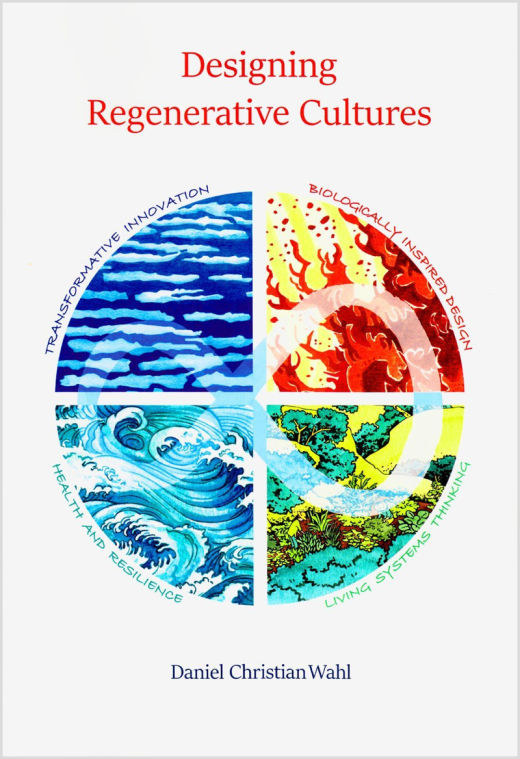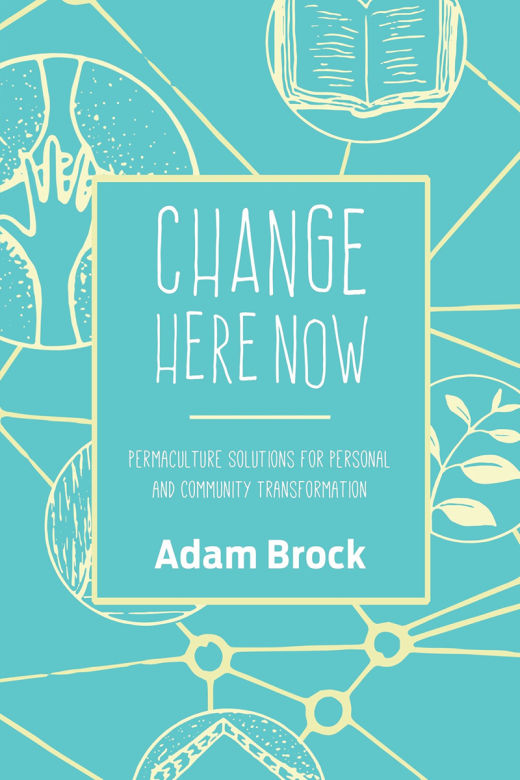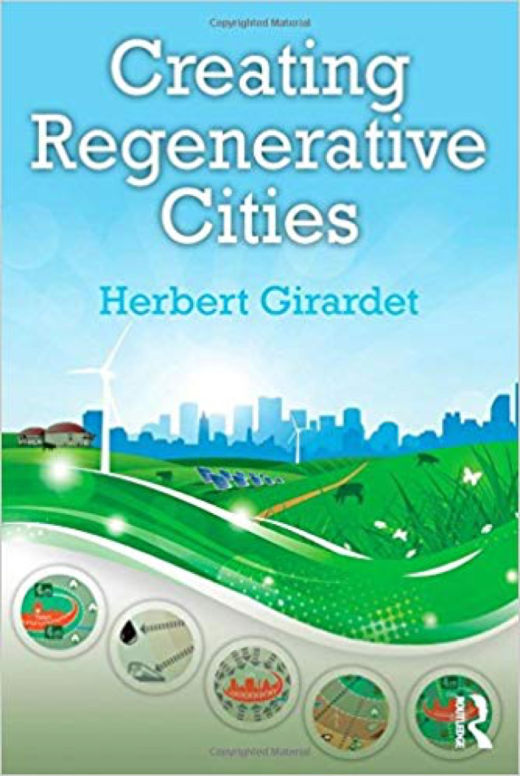David Towell reviews 3 books which help us to understand how we might create a future in which we live in harmony with each other and nature - for universal benefit.
David Towell reviews: Designing Regenerative Cultures by Daniel Christian Wahl, Change Here Now: Permaculture solutions for personal and community transformation by Adam Brock and Creating Regenerative Cities byHerbert Girardet.
The title of this article is the concluding sentence of my review of Capra and Luisi's textbook, The Systems View of Life. Capra and Luisi offer an excellent overview of recent scientific developments in several disciplines, especially biology and ecology, which offer us a fuller understanding of life in all its forms and inter-relationships. These three books show, in different ways, how we can apply this understanding to contemporary local and global challenges so as create a future in which we live in harmony with ourselves, each other and nature - for universal benefit. They tell a new story of fundamental importance.

Daniel Wahl's book is the most erudite and ambitious. Drawing on a wide range of contemporary sources, especially in the field of applied ecology, he seeks to both inform and inspire our collective efforts to make the fundamental change from a destructive separateness from the rest of life (intrinsic to capitalism, globalisation and our very careless use of fossil fuel based technologies) to a radically different perspective that unites humanity in our interdependence with the wider community of life (following Thich Nhat Hanh he calls this interbeing) and that helps us find ways of working with each other and nature to co-create the conditions for all life to flourish. This then is what he means by developing 'regenerative cultures': regenerative rather than merely sustaining because so much damage has been done already that we have a major task of restoration if we are to ensure that we leave a better world to each subsequent generation.
'Design' in his title sometimes means borrowing from nature, as in various products (from swimsuits to sky-scrapers) based on biomimicry. In relation to changing more complex systems, it relies on our willingness to engage with uncertainty through working together to address fundamental questions and looking for direction and innovation which predicate this better future. The whole book is framed around groups of these questions.
So Wahl shows how this approach is being increasingly applied successfully in many areas of life. Permaculture ideas are shaping the shift in agriculture to resilient local food systems (and showing how we can sequester carbon in the soil at the same time). New economics is showing us how to create circular economies - where all resources are used and re-used productively. Green thinking is helping us shift away from fossil fuels to solar power and production using plant-based chemistry. In a few jurisdictions, where indigenous cultures are still strong, we are seeing the law accord rights to all species and nature as a whole. And as we shall explore later, ecological thinking is a powerful basis for city planning and the development of sustainable communities.

Adam Brock's book has some similar origins (learning from ecology and especially permaculture) and covers much common ground, but in a very different format. Essentially, Change Here Now is a reference book, a compendium of 82 'patterns' (together constituting a 'pattern language') which encapsulate often simple ways of thinking about issues arising in achieving personal and social change.
By permaculture, Brock means finding good ways of meeting human needs while restoring ecosystem health. He cites Holmgren who identifies 12 core principles of permaculture design (David Holmgren Permaculture: Principles and Pathways Beyond Sustainability, 2002). These principles have, of course, been an important underpinning to the 'Transition Towns Movement'.
The 82 patterns each name a key idea, show how it illuminates particular kinds of problems and their contexts...and offer practical examples of its use. The concept behind the book is that when we are working on complex change problems, we scan these patterns to see which seem best to illuminate our problem and explore what innovative ideas they offer for problem solution.
The first 16 of these patterns are formulated as high level guidance for addressing a broad range of challenges. For example, meaningful change is a long process; humans co-evolved with other species and we are not whole without their presence; there are many kinds of capital and considerable scope for us to reclaim these as part of our shared 'commons'; the most resilient and just systems are those that are managed at the smallest practical scale; we need protected spaces in which beneficial changes can be incubated; there are different ways of knowing, not just scientific inquiry; design is a creative process which involves experimentation and learning, etc.
The remaining 66 patterns are more focused applications of permaculture ideas arranged according to different kinds of social challenge - including our efforts to create the new economy, work effectively in groups and organisations of different sizes and strengthen participatory democracy. All this offers much food for creative thought, not least in our efforts to become what Wahl (after Tom Atlee) calls 'evolutionary activists'.

Herbert Girardet seeks to apply this ecological approach and many of these ideas to how we develop cities of the future, consistent with the UN Sustainable Development Goals, especially Goal 11.
Towns and cities need to be a major focus for our efforts. They are increasingly our habitat of choice; the ways we have chosen to live in them are a huge threat to the natural world and therefore the capacity of all life to flourish; and at the same time they are typically a focus for political leadership and democratic participation and places where there are potentially lots of resources to support innovation.
Girardet presents his analysis as a simple but powerful story, tracing the evolution of cities and offering a very readable account of what is now required. For much of recorded history, most towns were relatively isolated population centres largely self-sufficient in relation to their own local countryside. He calls this tradition Agropolis.
Since about the 1750s in Britain, more recently is developing countries, the industrial revolution with its fossil fuel dependency has taken us in the direction of Petropolis. Much larger cities - and now megacities - which are globally connected (relying on global supplies also transported using fossil fuel technologies) and imposing massive ecosystem damage through what Girardet describes as their 'linear' metabolism i.e. they take resources, both organic and inorganic from the countryside, use these to support high consumption lifestyles and then discharge much of the waste as different kinds of pollution: carbon dioxide into the atmosphere, manufactured products into land-fill, plastic and sewage into our rivers and oceans.
Globally, we are still racing along this unsustainable track and living way beyond what our planetary boundaries permit, despite growing awareness of the awful consequences in global warming and biosphere destruction.
Like Wahl and Brock, Girardet looks to our understanding of living systems to envision the regenerative towns and cities of the near future, what he calls Ecopolis - or more simply, Ecocities. Mimicking nature, Ecocities need to establish circular metabolic systems, like traditional Agropolis but now with much larger populations, in which the city is re-embedded in its local hinterland, greatly reducing its eco-footprint and learning how to minimise waste and return water and organic products to the countryside - assisted by 'Smart City' technologies. Among other things this requires:
Clearly this is a 'big ask' and requires massive infrastructural investment, even more so if global population continues to grow. But it is also essential and certainly possible. Global initiatives like UN Habitat are stimulating widespread learning and exchange. Girardet offers a series of contemporary case studies on different scales which include comprehensive transformational strategies, for example in Adelaide and Copenhagen; eco-district demonstration projects like the Beddington Zero Energy Development in South London; and specific changes like the concentrated solar power station near Seville, the rapid growth in urban agriculture needed to feed Havana following the fall of the Soviet Union and the major watershed project in China's Loess Plateau to restore a greatly degraded rural ecosystem.
Achieving this radical transformation is the pre-eminent challenge of our times. The ecological clock is ticking closer to midnight. Informed by our understanding of living systems, can we find the political will, individually and collectively, to create - and live - a better way?
Daniel Christian Wahl: Designing Regenerative Cultures, Triarchy Press © 2016.
Adam Brock: Change Here Now: Permaculture solutions for personal and community transformation, North Atlantic Books © 2017.
Herbert Girardet: Creating Regenerative Cities, Routledge © 2015.
Review: Learning From Nature - with nature as our mentor another world is possible © David Towell 2018.
All Rights Reserved. No part of this paper may be reproduced in any form without permission from the publisher except for the quotation of brief passages in reviews.
Sustainability, Global, Reviews